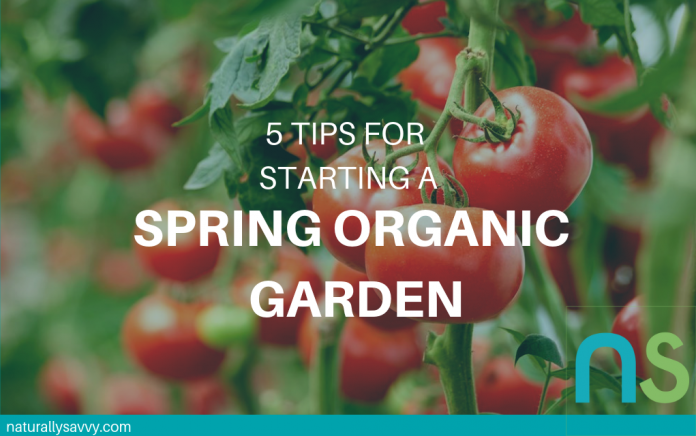
So you want to grow your own organic food? Awesome! Spring is the perfect time to get your hands dirty and create some magic in the garden.
1. Tip number one is choosing a location that can house your organic plants.
Start by picking an area that is exposed to at least seven hours of sunlight a day and has proper drainage. Planting in natural soil has many benefits, including providing the nutrients for healthy plants and a strong yield. If you’re planting in your yard be sure to pick an area that has a fence or other protection from larger pests such as rabbits, rodents, or deer.
Raised beds are a good solution if you want to grow organic plants in compromised soil or otherwise inhospitable conditions. If you decide to invest in a raised bed, start by creating a border around the bed with brick, stone or natural wood to shield the soil from potential contaminants. The border should be at least 16 inches high to ensure that the roots are protected. If you decide to use a container garden and have limited space you may want to try a Tower Garden, which offers a great solution to growing a variety of plants in little space. Raised beds and container gardens require more work to maintain optimal soil and irrigation conditions but they make gardening accessible to everyone because you can build this type of garden anywhere.
2. The second tip is to pick and locate your organic tools, seeds, and materials.
Organic gardening requires many of the same tools as any other garden: a rake, a hoe, compost, mulch, soil, seed starter, and seeds or seedlings. But organic differs in that you must choose certified organic seeds. Organic seeds and seedlings will carry the USDA organic seal. A great online resource is Park Seeds. You’ll want to avoid potting mixes, seed starters, or bags of soil that are not certified organic. Call ahead to your local garden center to make sure they carry organic gardening supplies.
Even with a perfect tract of soil, raised bed or container, you still have to choose the plants or crops that grow best in your region and climate. To get the highest yield, research which ones thrive in your area. You’ll also want to pick crops that you are excited about to make for a celebratory harvest. Consider planting, “companion plants,” close to your primary plants. These can provide necessary nutrients to help your crops grow and often times repel pests that would otherwise be attracted to your plants. Once you pick the desired plants for your garden research the companion plants that will support your primary crop.
Read more: 3 Grow-Your-Own Foods Guaranteed to Impress Your Friends
3. Tip number three for planting a spring garden is to prepare your soil in either the ground or in your raised beds as early as possible.
Start by tilling the soil down to 12 inches and remove rocks and debris. Next fill the bed with a mix of organic compost and organic soil and start preparing the bed for planting.
Now that you’re ready to plant your garden, grab your organic seeds, seed starter or seedlings and follow spacing, depth and light requirements provided on the packaging or seedling insert.
4. Our fourth tip encompasses how to actually grow your garden.
Failure in any of these areas is what separates the enthusiasts from the gardeners. Dealing with the challenges of warding off pests, properly irrigating and tending to your crops can become discouraging. Don’t worry, Naturally Savvy has you covered!
Keep an eye out for pests. If companion plants don’t repel all pests, then create deterrents such as traps. For example, slugs and snails can be trapped easily with slug traps. Neem oil and other natural horticultural oils can deter particularly insistent pests, without relying on synthetic chemical pesticides. At least twice a week flip over a leaf to look for pests such as aphids or other pests. If you find aphids, introduce ladybugs as your beneficial insects. Ladybugs can consume up to 50 to 60 aphids a day! Live ladybugs can be purchased at your garden supply store or ordered online. Kids will love to help release these insects so involve them in this fun organic gardening step.
Also, look for missing leaves and bites larger than your thumb as this is a sign of larger pests. Barriers such as crates, scarecrows, netting, reemay cloth, and fencing can help thwart pesky invaders such as deer, rodents, birds, and rabbits.
If you’re watering your garden by hand rather than relying on a soaker hose or drip system, do it in the morning. This practice will increase the amount of water that your plants retain while also making it less likely that harmful mildew or mold will form. Soaker hoses or drip systems can ensure that your garden’s temperature and moisture remain consistent and controlled, improving the odds that you’ll have a full harvest. Some prefer hand watering and others rely on a drip system, it’s key to pick what works with your schedule so you can be consistent. Important note: be sure to water the soil rather than the leaves and research the best watering practices for your particular crop.
Be sure to adjust and maintain a soil pH level of about 6.5-7.0. Your garden supply store should carry a pH meter and pamphlet to help you test and adjust levels. If not, you can order one online. Remember to use companion plants and cover crops in between planting to nurture the soil and it’s also a great organic practice by gardeners and farmers alike. Other important soil requirements are compost and earthworms. If you don’t have earthworms, don’t worry! You can even purchase worms at your garden supply store or order them online.
Read more: The Tao of Gardening
5. Our fifth and final tip covers how to properly harvest and care for your produce.
At it’s peak harvest time a garden requires constant picking as many crops will turn to seed and stop producing. Most vegetables reach their peak flavor when they're young and tender so you’ll want to research the optimal time to pick each tasty crop for your region and pay attention to frequency.
Harvesting your garden can be the most rewarding experience. You’ll be amazed at the taste and quality once you bite into that first homegrown carrot. Aside from the sheer joys of growing and eating your own foods, there are multiple studies on the increase of nutritional value in fresh foods. As your organic garden grows, you’ll notice that the bees, butterflies, birds and other pollinators will be enjoying your garden as much as you.
Once you’ve harvested, you can enjoy your food throughout the growing season by using our recipes on Naturally Savvy. Depending on your desired crops some items need to be left on the counter, some refrigerated and some processed so be sure to research this so you’re ready for maximum flavor and shelf life. If you’re living in climates that have a short growing season you’ll want to plan on freezing, canning and drying some of your harvest so you can enjoy it during the winter months.
Happy Spring and happy planting!
DISCLAIMER: This article contains affiliate links, which means that if you click on one of the product links, Naturally Savvy will receive a small commission so we can keep pumping out amazing articles like this one. Thank you so much for your support!










